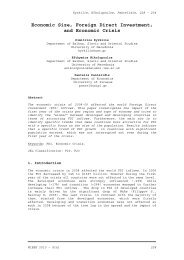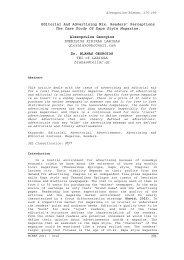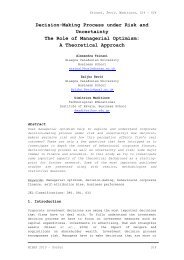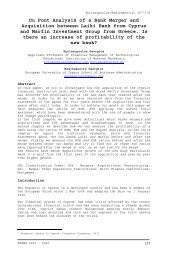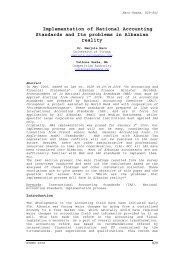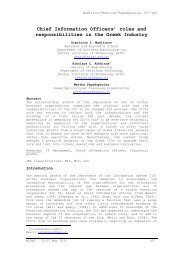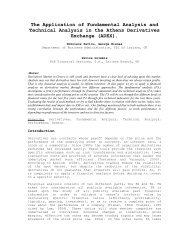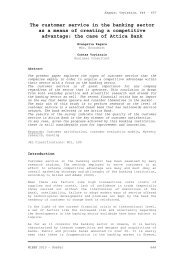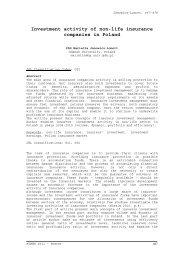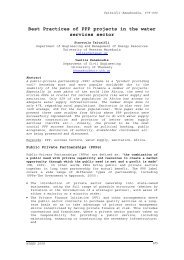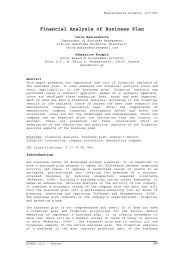Yilmaz B. S., Competitive Advantage Strategies for SMES in ... - mibes
Yilmaz B. S., Competitive Advantage Strategies for SMES in ... - mibes
Yilmaz B. S., Competitive Advantage Strategies for SMES in ... - mibes
Create successful ePaper yourself
Turn your PDF publications into a flip-book with our unique Google optimized e-Paper software.
Burcu Sel<strong>in</strong> <strong>Yilmaz</strong>, 106-117<br />
than shap<strong>in</strong>g is natural <strong>in</strong> stable bus<strong>in</strong>ess environments, where key<br />
elements of <strong>in</strong>dustry structure and conduct – such as technology<br />
plat<strong>for</strong>ms, regulations, competitors, and customer purchas<strong>in</strong>g patterns<br />
– appear to be locked-<strong>in</strong> and difficult to change.<br />
In more uncerta<strong>in</strong> markets, however, many of these key elements may be<br />
<strong>in</strong>decisive and unstable, and hence susceptible to be<strong>in</strong>g shaped. A<br />
company’s decision to adopt a new technology, <strong>for</strong> example, may help<br />
establish that technology as the <strong>in</strong>dustry standard. Under what<br />
circumstances should companies attempt to proactively shape uncerta<strong>in</strong><br />
<strong>in</strong>dustry structure and conduct, and when is it better to reactively<br />
adapt to <strong>in</strong>dustry changes over time?<br />
Whether a company chooses to shape or adapt, strategy <strong>in</strong>variably<br />
<strong>in</strong>volves mak<strong>in</strong>g at least some major commitments that are difficult to<br />
reverse. These <strong>in</strong>clude acquisitions, capital <strong>in</strong>vestments, and choices<br />
about the design of the bus<strong>in</strong>ess system. The tim<strong>in</strong>g of such<br />
commitments is often the key to build<strong>in</strong>g and susta<strong>in</strong><strong>in</strong>g competitive<br />
advantage. In today’s global competitive environment, any bus<strong>in</strong>ess,<br />
large or small, that could not th<strong>in</strong>k and act strategically is<br />
extremely vulnerable.<br />
The rules of competitive game of bus<strong>in</strong>ess have changed dramatically.<br />
To be successful, companies can no longer do th<strong>in</strong>gs <strong>in</strong> the way they<br />
have always done them. Fortunately, successful companies have a<br />
powerful weapon to cope with a hostile, ever-chang<strong>in</strong>g, and uncerta<strong>in</strong><br />
bus<strong>in</strong>ess environment: the process of develop<strong>in</strong>g competitive advantage<br />
strategies.<br />
As one of the fastest grow<strong>in</strong>g <strong>in</strong>dustries of the global economy, the<br />
tourism <strong>in</strong>dustry consists of many small and medium size enterprises<br />
which try to be successful <strong>in</strong> an extremely competitive and rapidly<br />
chang<strong>in</strong>g bus<strong>in</strong>ess environment. To create competitive advantage <strong>in</strong> this<br />
environment, a small tourism enterprise has to choose a powerful<br />
strategy. The number of strategies from which the small tourism<br />
bus<strong>in</strong>ess owner can choose is <strong>in</strong>f<strong>in</strong>ite.<br />
This paper builds a theoretical background and provides propositions<br />
show<strong>in</strong>g how competitive advantage strategies are applied <strong>in</strong> small and<br />
medium-sized enterprises <strong>in</strong> the tourism <strong>in</strong>dustry. After evaluat<strong>in</strong>g<br />
<strong>for</strong>mer studies on competitive advantage and its applications <strong>in</strong> small<br />
and medium-sized enterprises <strong>in</strong> the tourism <strong>in</strong>dustry, based on a<br />
hypothetical example structured on an empirical study on the obstacles<br />
affect<strong>in</strong>g small bus<strong>in</strong>esses <strong>in</strong> tourism and their competitive advantage<br />
strategies, some competitive advantage strategies are suggested <strong>for</strong><br />
small and medium-sized enterprises <strong>in</strong> tourism.<br />
SMEs and SMEs <strong>in</strong> Tourism<br />
In today’s globalized world, SMEs have become more important <strong>for</strong> both<br />
developed and develop<strong>in</strong>g countries s<strong>in</strong>ce they generate significant<br />
percentages of overall production and employment. Def<strong>in</strong>itions of SMEs<br />
vary from country to country. Number of employees and total turnover<br />
-depend<strong>in</strong>g on the <strong>in</strong>dustry- are used as measures by The North American<br />
Industry Classification System. The European Union (EU) has created a<br />
uni<strong>for</strong>m def<strong>in</strong>ition: SMEs are <strong>in</strong>dependent enterprises which employ<br />
fewer than 250 persons and which have an annual turnover not exceed<strong>in</strong>g<br />
50 million euro and/or an annual balance sheet total not exceed<strong>in</strong>g 43<br />
MIBES 2008 107



